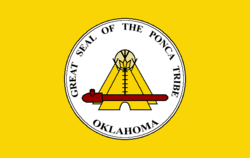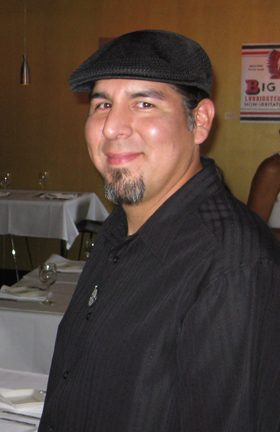Ponca Tribe of Indians of Oklahoma facts for kids

Flag of the Ponca Tribe of Oklahoma
|
|
| Total population | |
|---|---|
| 3,783 | |
| Regions with significant populations | |
| Languages | |
| Omaha-Ponca language, English | |
| Religion | |
| traditional tribal religion, Native American Church, Christianity | |
| Related ethnic groups | |
| Omaha, Otoe, Missouria, Ho-Chunk, Iowa, and other Siouan peoples |
The Ponca Tribe of Indians of Oklahoma, also known as the Ponca Nation, is one of two federally recognized tribes of Ponca people in the United States. The other is the Ponca Tribe of Nebraska. Both tribes traditionally speak the Omaha-Ponca language, which is part of the Siouan language family. They share many cultural traditions with the Omaha, Osage, Kaw, and Quapaw peoples.
Contents
Government
The Ponca Tribe of Indians of Oklahoma has a government run by a committee chosen by the people. Their main offices are in White Eagle, which is close to Ponca City, Oklahoma. The tribe's official area, called a tribal jurisdictional area, includes parts of Kay and Noble counties.
As of 2018, there were 3,783 members in the tribe. To become a member, a person needs to have at least 1/8 Ponca ancestry, based on the tribe's own rules.
How the Government Works
The Ponca Tribe's government is led by a seven-member group called the Business Committee. These members are chosen by the people in elections and serve for four years. One person is elected as the chairman, who leads the committee. Other important roles include the vice-chairman and the secretary/treasurer.
The people currently serving on the Business Committee are:
- Oliver Little Cook, Chairman
- Robert Collins, Vice-Chairman
- Carla Carney, Secretary Treasurer
- Matilda De La Garza, Business Committee Member
- Scotty Simpson Jr., Business Committee Member
- Earl Howe III, Business Committee Member
Language and Culture
In 2009, about 33 tribal members still spoke the Ponca language. The tribe works to keep their language alive.
Every year since 1876, the tribe holds a special gathering called a powwow. This event is a homecoming celebration and takes place in August in Ponca City. It's a time for dancing, singing, and celebrating their culture.
History
The Ponca tribe was one of five tribes that lived in the area northeast of the Mississippi River. The Ponca and the Omaha tribe separated from the others in the early 1700s. They were moving west from the Great Lakes region before Europeans arrived in America. The Ponca eventually settled in what is now Nebraska and South Dakota.
After Europeans came to America, diseases like Smallpox, Measles, and Influenza spread. These diseases were new to the Ponca people, and they did not have immunity to them. Many Ponca people died in the 1700s and 1800s because of these illnesses. At the same time, the powerful Sioux (also known as the Lakota) started moving onto Ponca lands.
Treaties with the United States
The Ponca tribe never fought a war against the United States. They signed their first peace treaty with the U.S. government in 1817. In 1825, they signed an agreement about trade. Later, in 1858 and 1865, they signed treaties that gave some of their lands to the U.S. government.
The 1860s and 1870s were very hard for the Ponca. The buffalo, which they relied on for food, were disappearing. There were also droughts that ruined their crops. On top of that, they faced conflicts with the Sioux. All these problems made it difficult for the Ponca to find enough food.
Forced Relocation
The U.S. government did not keep many of its promises to the Ponca. In 1868, the government gave land that was supposed to be for the Ponca to the Sioux. This was part of a larger agreement called the Great Sioux Reservation. Then, in 1877, the government forced the Ponca to move to Indian Territory, which is now Oklahoma.
The forced move from their home in South Dakota to Indian Territory was very poorly managed. The U.S. government did not listen to the tribal leaders or ask for their ideas. As a result, the Ponca arrived too late to plant crops. The government also did not give them enough supplies. To make things worse, their new location had a lot of malaria, a serious disease.
In the first year after the move, about 158 Ponca people died. This was almost one-third of the entire tribe. One of those who died was the oldest son of Standing Bear, a Ponca chief.
Standing Bear decided to take his son's body back to Nebraska to bury him in their traditional lands. When he arrived, the Army arrested him for leaving the reservation. However, a general named George Crook felt sympathy for Standing Bear. With help from lawyers who worked for free, Standing Bear went to court. The court case, called Standing Bear v. Crook (1879), was very important. It decided that Native American people had the right to use a legal process called habeas corpus (which means they could challenge their arrest in court). It also said that Native Americans had legal rights as citizens under U.S. law.
White Eagle, another important Ponca chief, settled on a large reservation in what would become Kay and Noble counties in Oklahoma. He was pressured to lease much of the land to the Miller Brothers 101 Ranch for animals to graze and later for oil drilling. In the 1890s, missionaries and government agents tried to make the Ponca stop their traditional dances and ways of life. They wanted to make the Ponca more like European-Americans.
In 1892, a law called the Dawes Allotment Act was passed. Under this law, the U.S. government recorded all the tribe members. Each family was given their own plot of land. The idea was to teach them how to own land individually and farm for themselves. This law also aimed to end tribal land claims in Oklahoma before it became a state. The government then called the remaining reservation land "extra" and sold it to European-American settlers.
From the 1900s to Today
When oil was found on Ponca lands in 1911, it had both good and bad effects. Some Ponca people became very rich, but others were tricked by people who wanted their land and quickly lost it.
In the 1910s, a new religion called Peyote religion became popular. In 1918, two educated Ponca men, Louis MacDonald and Frank Eagle, helped start the Native American Church.
After many Ponca people served in World War I, the returning soldiers started a local group called the American Legion Buffalo Post 38. In their community, they brought back traditional war dances, like the heluska dance.
In 1936, a law called the Oklahoma Indian Welfare Act helped the tribe reorganize their government. They officially approved their own constitution in 1950 and became a federally recognized tribe. Their main tribal offices were set up in White Eagle, south of Ponca City.
Clyde Warrior, a Ponca leader, helped start the National Indian Youth Council. He encouraged self-determination, which means Native American people should have the right to govern themselves. He inspired many young Native activists in the 1960s and 1970s.
Over the years, the land given to individual Ponca families under the Dawes Act became divided among many heirs. Also, in the late 1900s, it was found that the government had not properly managed the money owed to Native Americans for oil drilling and other leases on their land. In 2009, the U.S. government settled a big lawsuit called Cobell v. Salazar. This lawsuit was started in 1996 by Elouise Cobell, a Blackfeet woman.
The Ponca Tribe is now part of a program called the Land Buy-Back Program for Tribal Nations. This program was created as part of the lawsuit settlement. In 2016, government officials announced they offered about $7 million to over 1,300 landowners with small shares of land in the Ponca Tribe's area. This program buys back these small land shares and gives the land back to the tribe to use for the community.



